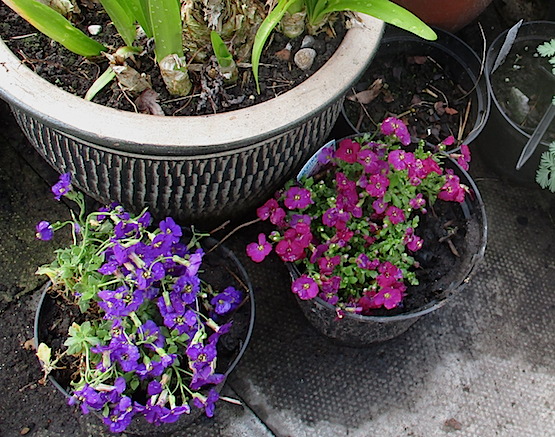Although I grow some primulas successfully they
have not naturalised in my garden by self seeding as much as I had expected.
The lower part of my garden is quite wet for long periods and most primulas
like copious moisture. Unfortunately some species just don't seem to like my
fine sandy soil.
 |
| I do manage to naturalise a few primulas |
My lack of success certainly seems to apply to
primrose and polyanthus. They survive a year or two when I plant them but then
they just fade away. It would seem that much of the gardening world has similar
experience as all year round primroses 'walk' in vast quantity off garden
centre shelves. Many gardeners in actual practice grow them as annuals or
perennials. An ideal nurserymans's plant!
My failures do not apply to double primrose, Primula vulgaris 'Nectarine'.
This has survived in my garden six years now. Perhaps significantly it grows in
a tub where it is not forgotten, never dries out or gets smothered in the open
ground by aggressive neighbours. It is never dehydrated by hedge roots or trees
and in full Summer can be placed in light shade.
 |
| Now in June it needs to be hidden away in the nursery. It would be a good time to divide it |
It flowers twice a year for me. Typically it
comes into flower sometime in February although this does depend on the kind of
Winter. It gives me ten weeks of colour before I tidy my tub away to my little
nursery where the plant goes semi dormant. Come late August it bursts into life
to gives me another three months before more severe Winter weather brings an end
to its season. Perhaps it is able to flower so long because as a double flower
it does not set seed.
Regular readers will know that all my tub
plants are grown in my own sandy soil and they are fed by YaraMila fertiliser applied
as a very light top dressing two or three times a year. (In truth when I
remember or should I judge that my plant needs further nutrition).
Although I do not remember ever dividing my 'Nectarine' I do know that normal primrose and polyanthus benefit from division
every few years when old plants can be rejuvenated.
 |
| These primroses have survived on a grave in Worsbrough cemetery for twenty years now. They are never divided but rejuvenate themselves by self seeding |
 |
| I have transplanted a few primroses to a wilder part of the cemetery and they have rewarded me by self seeding around |
Garden primroses have been extensively
hybridized for many years. New varieties come… and go. The genetic variation in
breeding has come from Primula vulgaris, Primula vulgaris sibthorpii and
Primula vulgaris balearica. Regular readers will know that hybridization
fascinates me and I wondered if Nectarine’s good constitution was the result of
any novel genes from a different primula species. No luck when I searched on the net but I did find that 'Nectarine' was bred by primula enthusiasts breeders David and Priscilla Kersley. It is one
of a series of double primulas marketed as the Belarina series. Apparently the
petals are edible and can be used for cake decoration.
I don’t suppose they taste as good as a
nectarine.
 |
| Whoops I have noticed from my pictures that the plant is spotted with leaf hopper damage. It is of very little consequence |
Moving pots around
An advantage of containers is that your plants
can be shifted to compose attractive groupings. I am not sure if I have quite
succeeded?
 |
| Nectarine and pittosporum |
 |
| My hyacinths have ‘gone over’ but a backcloth of Corydalis flexuosa remains |
 |
| Dicentra cucullaria does particularly well in tubs |
A further note on leaf hoppers
More correctly called jassids you will get some
curious pictures if you do a net search for images as more exotic species are
used in fishing! It’s about the size of an aphid and you will have to be quick
to find the culprit as it immediately hops away! My poor picture is of a static
nymph stage in its life cycle.
Leaf hoppers are to be found on a wide range of
plants but are usually of little concern
If you google ‘leaf hopper’ you will gets loads
of pictures of froghoppers! That’s ‘cuckoo spit’ and quite different!
 |
| Mottling caused by jassid 'flies'(leaf hoppers) |
The damage caused by leaf hoppers is a faint
mottle on the leaf surface and is usually insignificant. If I had not been
writing this post I would not know I had it!
If badly grown already stressed plants succumb
to leaf hoppers it can be controlled by most general purpose aphid killers
I have previously posted about growing Dicentra cucullaria and Corydalis flexuosa
I have gone on
about my Yaramila fertilizer several times.































